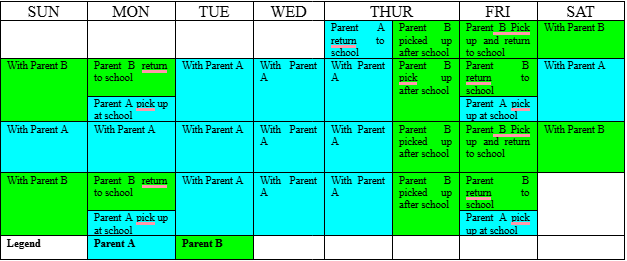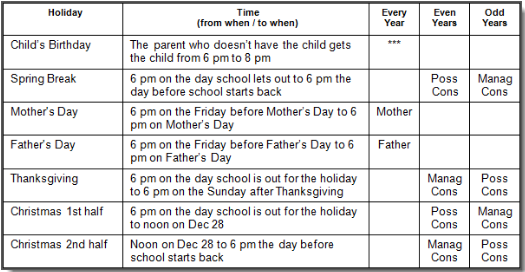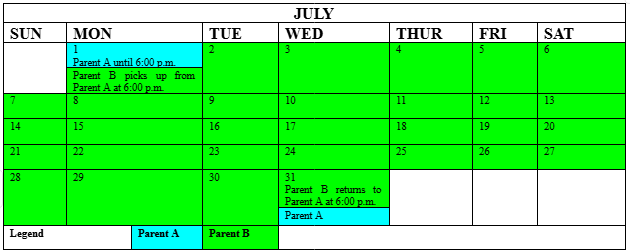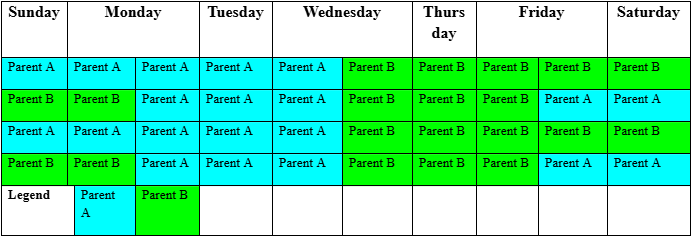If you have children and are filing for a divorce, or wanting to establish possession and access of, custody, or visitation, these are two issues you and your spouse/other parent will have to work through. Texas uses the terms “possession” and “access” to refer to visitation and custody matters.
Possession of your child refers to any time you can see your child in person, while access refers to the time you interact with your child by phone, e-mail, or text message.
Standard Possession Orders (SPO)
A standard possession order provides the non-primary parent with additional time with their child. The non-primary parent gets an extra overnight visit on Thursdays and does not need to return possession of the child to the primary parent until the Monday following his/her regular weekend possession.
The child visits the possessory conservator as follows:
- Every 1st, 3rd, and 5th weekend when school is dismissed on Thursday until school resumes on Friday. Pick up after school on Friday and return to school on Monday.
- Below is a chart that shows the standard possession schedule during the school year.

Holidays
The holiday schedule for the standard order is as follows (unless agreed to otherwise in writing):
If the child has a Friday School holiday on the weekend of a visit (1st, 3rd, and 5th weekends), the visit starts when school is dismissed on Thursday as normal. If the child has a Monday school holiday on the weekend of a visit, the visit is extended until Monday at 6 p.m. Please see below:

The typical holiday school for the standard possession and access order is as follows:

SUMMERTIME
Summer vacation time is different than the school year possession and access time. A summer break schedule is when you have a different residential schedule during your child’s summer break. The default of the summer break is below (times can vary based on agreement in writing). *The dates may not accurately reflect the month of July in the given year you are reviewing this document.* April 1st of each year is the deadline for Parent B to designate their 30 days of extended summer possession. If Parent B does not notify Parent A in writing by April 1st of each year, the default time is the entire month of July.

Another change that happens in the summer is the 1st, 3rd and 5th weekend for Parent B. Parent B will pick up the child on Friday at 6 p.m. and return the child at 6:00 p.m. on Sunday. Also, Parent B will not have a Thursday possession period during the summer.
50/50 Child Possession and Access to Schedules.
There are several different ways to split 50/50 child possession between parents. Here are some common ones, but each family is different and unique, and you may come to an agreement that is similar or a combination of the following examples.
2-2-3
Pros and cons of the 2-2-3 schedule
Pros:
- Children are able to spend time with both parents each week.
- Children don’t go very long before seeing either parent.
- The schedule is structured and can be easily implemented.
- The schedule can work with unusual employment schedules.
- Parents have equal time with the children, which can reduce conflict.
- This schedule can work for younger children who aren’t in school.
- This is a shared parenting schedule, and both parents perform daily caretaking.
Cons:
- The frequent exchanges take time and planning.
- Children may not do well changing homes so frequently.
- Parents must take extra care to keep each other informed about the children’s schoolwork and activities.
- Parents must live close to each other and close to the children’s school.
- Parents must be able to communicate well with each other.
Days that both parents are on schedule – drop off at school and pick up from school

2-2-5
Pros and cons of the 2-2-5 schedule
Pros:
- Your child can spend time with both parents each week.
- Your child doesn’t go a long time without seeing a parent.
- The schedule is consistent and fairly easy to remember.
- Parents have equal time, so there may be less fighting about the schedule.
- This is a shared parenting schedule, so both parents provide daily caregiving.
- This schedule can work very well if parents have nontraditional work schedules.
- This schedule can work well for younger children who aren’t in school.
Cons:
- There are frequent exchanges that the parents must remember and keep track of.
- One parent may have the child every weekend.
- Your child changes homes frequently and may struggle with adapting.
- Since your child will spend weekdays in both parents’ homes, the parents must communicate about school and activities.
- The parents must live relatively close to each other.
- If the child is in school, both parents must live close to the school.
Days that both parents are on schedule – drop off at school and pick up from school

Week On/Week Off
Pros and Cons of Week On/Week Off
Pros:
- Parents have a long period with their children.
- Parents have the children for the same amount of time, so there may be less conflict over the schedule.
- There are limited exchanges.
- You can add midweek or overnight visits, so the children don’t spend an entire week away from either parent.
- It provides consistency for children who struggle with change.
- It often helps children stay current on school assignments and homework.
Cons:
- Parents of school-aged children must live within a reasonable distance of the school.
- Parents must live reasonably close to each other.
- Some children struggle with having two residences.
- Parents must communicate frequently and keep each other updated on school and activities.
- Parents and/or children may struggle being apart for an entire week
Drop off and Pick Up happen on Sunday, typically at 6:00 p.m.– receiving parent picks up

